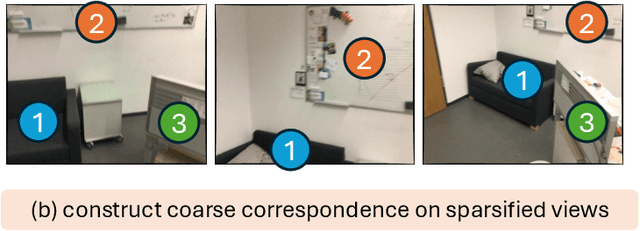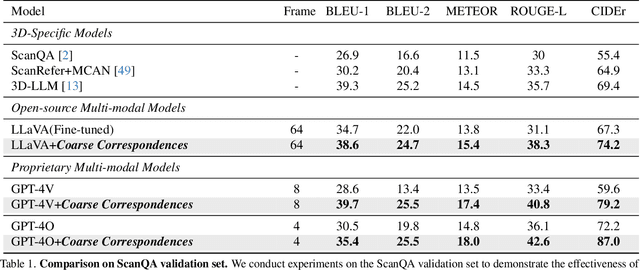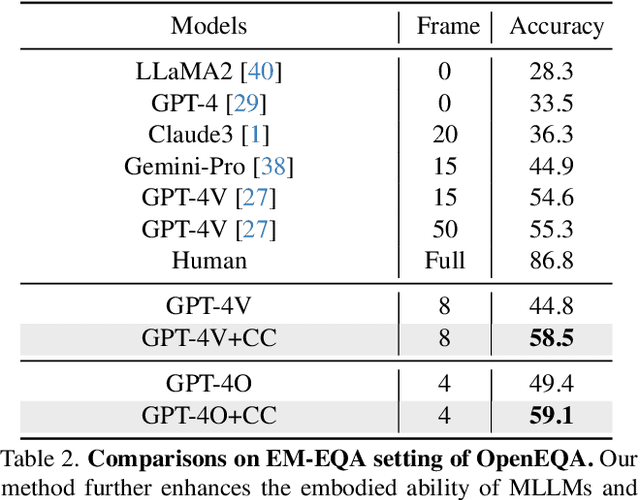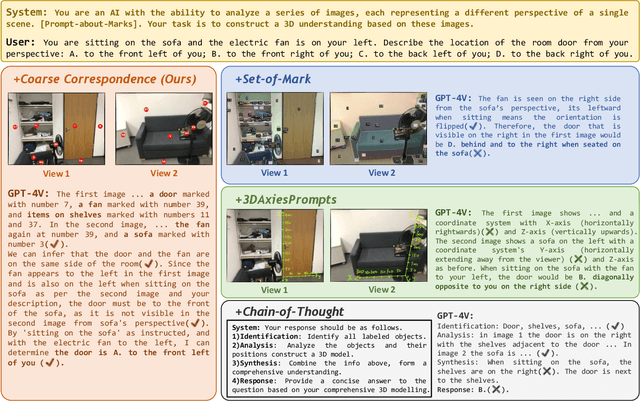Yuhao Dong
Visual Grounding from Event Cameras
Sep 11, 2025Abstract:Event cameras capture changes in brightness with microsecond precision and remain reliable under motion blur and challenging illumination, offering clear advantages for modeling highly dynamic scenes. Yet, their integration with natural language understanding has received little attention, leaving a gap in multimodal perception. To address this, we introduce Talk2Event, the first large-scale benchmark for language-driven object grounding using event data. Built on real-world driving scenarios, Talk2Event comprises 5,567 scenes, 13,458 annotated objects, and more than 30,000 carefully validated referring expressions. Each expression is enriched with four structured attributes -- appearance, status, relation to the viewer, and relation to surrounding objects -- that explicitly capture spatial, temporal, and relational cues. This attribute-centric design supports interpretable and compositional grounding, enabling analysis that moves beyond simple object recognition to contextual reasoning in dynamic environments. We envision Talk2Event as a foundation for advancing multimodal and temporally-aware perception, with applications spanning robotics, human-AI interaction, and so on.
Talk2Event: Grounded Understanding of Dynamic Scenes from Event Cameras
Jul 23, 2025Abstract:Event cameras offer microsecond-level latency and robustness to motion blur, making them ideal for understanding dynamic environments. Yet, connecting these asynchronous streams to human language remains an open challenge. We introduce Talk2Event, the first large-scale benchmark for language-driven object grounding in event-based perception. Built from real-world driving data, we provide over 30,000 validated referring expressions, each enriched with four grounding attributes -- appearance, status, relation to viewer, and relation to other objects -- bridging spatial, temporal, and relational reasoning. To fully exploit these cues, we propose EventRefer, an attribute-aware grounding framework that dynamically fuses multi-attribute representations through a Mixture of Event-Attribute Experts (MoEE). Our method adapts to different modalities and scene dynamics, achieving consistent gains over state-of-the-art baselines in event-only, frame-only, and event-frame fusion settings. We hope our dataset and approach will establish a foundation for advancing multimodal, temporally-aware, and language-driven perception in real-world robotics and autonomy.
ShotBench: Expert-Level Cinematic Understanding in Vision-Language Models
Jun 26, 2025Abstract:Cinematography, the fundamental visual language of film, is essential for conveying narrative, emotion, and aesthetic quality. While recent Vision-Language Models (VLMs) demonstrate strong general visual understanding, their proficiency in comprehending the nuanced cinematic grammar embedded within individual shots remains largely unexplored and lacks robust evaluation. This critical gap limits both fine-grained visual comprehension and the precision of AI-assisted video generation. To address this, we introduce \textbf{ShotBench}, a comprehensive benchmark specifically designed for cinematic language understanding. It features over 3.5k expert-annotated QA pairs from images and video clips, meticulously curated from over 200 acclaimed (predominantly Oscar-nominated) films and spanning eight key cinematography dimensions. Our evaluation of 24 leading VLMs on ShotBench reveals their substantial limitations: even the top-performing model achieves less than 60\% average accuracy, particularly struggling with fine-grained visual cues and complex spatial reasoning. To catalyze advancement in this domain, we construct \textbf{ShotQA}, a large-scale multimodal dataset comprising approximately 70k cinematic QA pairs. Leveraging ShotQA, we develop \textbf{ShotVL} through supervised fine-tuning and Group Relative Policy Optimization. ShotVL significantly outperforms all existing open-source and proprietary models on ShotBench, establishing new \textbf{state-of-the-art} performance. We open-source our models, data, and code to foster rapid progress in this crucial area of AI-driven cinematic understanding and generation.
Ego-R1: Chain-of-Tool-Thought for Ultra-Long Egocentric Video Reasoning
Jun 16, 2025Abstract:We introduce Ego-R1, a novel framework for reasoning over ultra-long (i.e., in days and weeks) egocentric videos, which leverages a structured Chain-of-Tool-Thought (CoTT) process, orchestrated by an Ego-R1 Agent trained via reinforcement learning (RL). Inspired by human problem-solving strategies, CoTT decomposes complex reasoning into modular steps, with the RL agent invoking specific tools, one per step, to iteratively and collaboratively answer sub-questions tackling such tasks as temporal retrieval and multi-modal understanding. We design a two-stage training paradigm involving supervised finetuning (SFT) of a pretrained language model using CoTT data and RL to enable our agent to dynamically propose step-by-step tools for long-range reasoning. To facilitate training, we construct a dataset called Ego-R1 Data, which consists of Ego-CoTT-25K for SFT and Ego-QA-4.4K for RL. Furthermore, our Ego-R1 agent is evaluated on a newly curated week-long video QA benchmark, Ego-R1 Bench, which contains human-verified QA pairs from hybrid sources. Extensive results demonstrate that the dynamic, tool-augmented chain-of-thought reasoning by our Ego-R1 Agent can effectively tackle the unique challenges of understanding ultra-long egocentric videos, significantly extending the time coverage from few hours to a week.
EgoLife: Towards Egocentric Life Assistant
Mar 05, 2025Abstract:We introduce EgoLife, a project to develop an egocentric life assistant that accompanies and enhances personal efficiency through AI-powered wearable glasses. To lay the foundation for this assistant, we conducted a comprehensive data collection study where six participants lived together for one week, continuously recording their daily activities - including discussions, shopping, cooking, socializing, and entertainment - using AI glasses for multimodal egocentric video capture, along with synchronized third-person-view video references. This effort resulted in the EgoLife Dataset, a comprehensive 300-hour egocentric, interpersonal, multiview, and multimodal daily life dataset with intensive annotation. Leveraging this dataset, we introduce EgoLifeQA, a suite of long-context, life-oriented question-answering tasks designed to provide meaningful assistance in daily life by addressing practical questions such as recalling past relevant events, monitoring health habits, and offering personalized recommendations. To address the key technical challenges of (1) developing robust visual-audio models for egocentric data, (2) enabling identity recognition, and (3) facilitating long-context question answering over extensive temporal information, we introduce EgoButler, an integrated system comprising EgoGPT and EgoRAG. EgoGPT is an omni-modal model trained on egocentric datasets, achieving state-of-the-art performance on egocentric video understanding. EgoRAG is a retrieval-based component that supports answering ultra-long-context questions. Our experimental studies verify their working mechanisms and reveal critical factors and bottlenecks, guiding future improvements. By releasing our datasets, models, and benchmarks, we aim to stimulate further research in egocentric AI assistants.
Ola: Pushing the Frontiers of Omni-Modal Language Model with Progressive Modality Alignment
Feb 06, 2025



Abstract:Recent advances in large language models, particularly following GPT-4o, have sparked increasing interest in developing omni-modal models capable of understanding more modalities. While some open-source alternatives have emerged, there is still a notable lag behind specialized single-modality models in performance. In this paper, we present Ola, an Omni-modal language model that achieves competitive performance across image, video, and audio understanding compared to specialized counterparts. The core design of Ola lies in its progressive modality alignment strategy that extends the supporting modality of the language model progressively. Our training pipeline begins with the most distinct modalities: image and text, then gradually expands the skill sets of the model using speech data that connects language and audio knowledge, and video data that connects all modalities. The progressive learning pipeline also enables us to maintain a relatively small size of the cross-modal alignment data, making developing omni-modal from existing vision-language models easy and less costly. Moreover, to unlock an advanced interactive experience like GPT-4o, we further design a sentence-wise decoding solution for streaming speech generation. Extensive experiments demonstrate that Ola surpasses existing open omni-modal LLMs across all modalities while achieving highly competitive performance compared to state-of-the-art specialized models of similar sizes. We aim to make Ola a fully open omni-modal understanding solution to advance future research in this emerging field. Model weights, code, and data are open-sourced at https://github.com/Ola-Omni/Ola.
Are VLMs Ready for Autonomous Driving? An Empirical Study from the Reliability, Data, and Metric Perspectives
Jan 07, 2025



Abstract:Recent advancements in Vision-Language Models (VLMs) have sparked interest in their use for autonomous driving, particularly in generating interpretable driving decisions through natural language. However, the assumption that VLMs inherently provide visually grounded, reliable, and interpretable explanations for driving remains largely unexamined. To address this gap, we introduce DriveBench, a benchmark dataset designed to evaluate VLM reliability across 17 settings (clean, corrupted, and text-only inputs), encompassing 19,200 frames, 20,498 question-answer pairs, three question types, four mainstream driving tasks, and a total of 12 popular VLMs. Our findings reveal that VLMs often generate plausible responses derived from general knowledge or textual cues rather than true visual grounding, especially under degraded or missing visual inputs. This behavior, concealed by dataset imbalances and insufficient evaluation metrics, poses significant risks in safety-critical scenarios like autonomous driving. We further observe that VLMs struggle with multi-modal reasoning and display heightened sensitivity to input corruptions, leading to inconsistencies in performance. To address these challenges, we propose refined evaluation metrics that prioritize robust visual grounding and multi-modal understanding. Additionally, we highlight the potential of leveraging VLMs' awareness of corruptions to enhance their reliability, offering a roadmap for developing more trustworthy and interpretable decision-making systems in real-world autonomous driving contexts. The benchmark toolkit is publicly accessible.
Insight-V: Exploring Long-Chain Visual Reasoning with Multimodal Large Language Models
Nov 21, 2024



Abstract:Large Language Models (LLMs) demonstrate enhanced capabilities and reliability by reasoning more, evolving from Chain-of-Thought prompting to product-level solutions like OpenAI o1. Despite various efforts to improve LLM reasoning, high-quality long-chain reasoning data and optimized training pipelines still remain inadequately explored in vision-language tasks. In this paper, we present Insight-V, an early effort to 1) scalably produce long and robust reasoning data for complex multi-modal tasks, and 2) an effective training pipeline to enhance the reasoning capabilities of multi-modal large language models (MLLMs). Specifically, to create long and structured reasoning data without human labor, we design a two-step pipeline with a progressive strategy to generate sufficiently long and diverse reasoning paths and a multi-granularity assessment method to ensure data quality. We observe that directly supervising MLLMs with such long and complex reasoning data will not yield ideal reasoning ability. To tackle this problem, we design a multi-agent system consisting of a reasoning agent dedicated to performing long-chain reasoning and a summary agent trained to judge and summarize reasoning results. We further incorporate an iterative DPO algorithm to enhance the reasoning agent's generation stability and quality. Based on the popular LLaVA-NeXT model and our stronger base MLLM, we demonstrate significant performance gains across challenging multi-modal benchmarks requiring visual reasoning. Benefiting from our multi-agent system, Insight-V can also easily maintain or improve performance on perception-focused multi-modal tasks.
Coarse Correspondence Elicit 3D Spacetime Understanding in Multimodal Language Model
Aug 01, 2024



Abstract:Multimodal language models (MLLMs) are increasingly being implemented in real-world environments, necessitating their ability to interpret 3D spaces and comprehend temporal dynamics. Despite their potential, current top models within our community still fall short in adequately understanding spatial and temporal dimensions. We introduce Coarse Correspondence, a simple, training-free, effective, and general-purpose visual prompting method to elicit 3D and temporal understanding in multimodal LLMs. Our method uses a lightweight tracking model to find object correspondences between frames in a video or between sets of image viewpoints. It selects the most frequent object instances and visualizes them with markers with unique IDs in the image. With this simple approach, we achieve state-of-the-art results on 3D understanding benchmarks including ScanQA (+20.5\%) and a subset of OpenEQA (+9.7\%), and on long-form video benchmarks such as EgoSchema (+6.0\%). We also curate a small diagnostic dataset to evaluate whether MLLMs can reason about space from a described viewpoint other than the camera viewpoint. Again, Coarse Correspondence improves spatial perspective-taking abilities but we highlight that MLLMs struggle with this task. Together, we demonstrate that our simple prompting method can significantly aid downstream tasks that require 3D or temporal reasoning.
Efficient Inference of Vision Instruction-Following Models with Elastic Cache
Jul 25, 2024Abstract:In the field of instruction-following large vision-language models (LVLMs), the efficient deployment of these models faces challenges, notably due to the high memory demands of their key-value (KV) caches. Conventional cache management strategies for LLMs focus on cache eviction, which often fails to address the specific needs of multimodal instruction-following models. Recognizing this gap, in this paper, we introduce Elastic Cache, a novel approach that benefits from applying distinct acceleration methods for instruction encoding and output generation stages. We investigate the metrics of importance in different stages and propose an importance-driven cache merging strategy to prune redundancy caches. Instead of discarding less important caches, our strategy identifies important key/value vectors as anchor points. Surrounding less important caches are then merged with these anchors, enhancing the preservation of contextual information in the KV caches while yielding an arbitrary acceleration ratio. For instruction encoding, we utilize the frequency to evaluate the importance of caches. Regarding output generation, we prioritize tokens based on their distance with an offset, by which both the initial and most recent tokens are retained. Results on a range of LVLMs demonstrate that Elastic Cache not only boosts efficiency but also notably outperforms existing pruning methods in language generation across various tasks. Code is available at https://github.com/liuzuyan/ElasticCache
 Add to Chrome
Add to Chrome Add to Firefox
Add to Firefox Add to Edge
Add to Edge